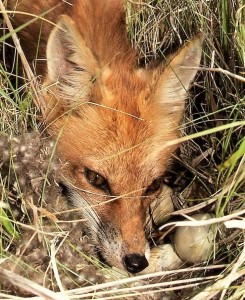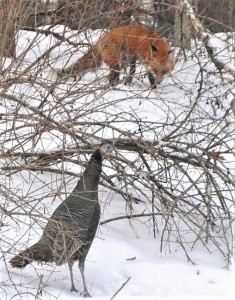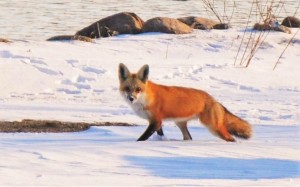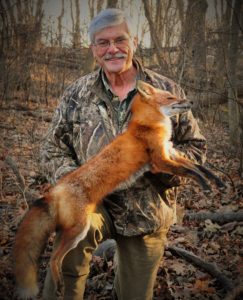Photography courtesy of Lowell Washburn, all rights reserved.
I trapped a prime red fox the other day. I don’t do much trapping anymore, and the fox came as a bit of a surprise. Although the set was located where I’ve seen fox or fox tracks in the past, I figured that I was most likely to catch a raccoon. In reality, catching the fox was probably as much accident as anything. One thing is certain, though. Seeing that fox brought back a flood of hunting and trapping memories from days gone by.
I shot my first fox when I was 14. Dad and I were hunting pheasants when a big vixen erupted from cover, almost at my feet. A load of #6 birdshot brought it to bag and, thanks to a tolerant mother, the beautiful hide soon decorated my bedroom wall. I’ve never been a great hunter or trapper of wild foxes, but I have had enough experience with the species to realize that Ol’ Red posses a better than average level of intelligence. For anyone looking for a lesson in humility, I highly recommend trying to stalk or trap a red fox.
The red fox is one of Iowa’s most interesting and controversial forms of wildlife. When it comes to human perspective, the fox is loved, hated, respected, and despised. The irony is that it is possible for all of these emotions to be displayed, simultaneously, by a single person.
The Dark Side: To a pheasant or duck hunter, the red fox is often regarded as an unwelcome destroyer of nests, eggs, and chicks. Rabbit and squirrel hunters may consider the fox to be a direct competitor for small game. Rural poultry hobbyists, are quick to loath the fox’s nighttime visits to “predator proof” enclosures.
The Flip Side: Other folks take a more positive view and think of the fox as a challenging and valuable natural resource that, whether trapped or hunted, has the potential to provide exciting, high quality outdoor recreation. They also note that although fox will take rabbits, squirrels, or pheasants; the bulk of their year-round diet is more likely to be comprised of rodents such as meadow voles and mice. Anyone who has ever staked out a den with active pups is already aware of the fox’s value as a highly entertaining and watchable form of wildlife.
Conclusion: So all things considered, is the red fox our friend, or is it our foe? Is it a villain or a valued resource? Amazingly, the answer to each of those questions is yes.
First and foremost, the red fox is a predator. Fox are also omnivorous opportunists, and will consume whatever seasonal delicacies may come their way. As vividly portrayed in children’s storybooks, the fox is indeed sly and cunning. During spring and early summer, fox are effective nest predators. Of course, raccoons, skunks, and ‘possums also find and destroy the nests of ground nesting birds. The notable difference is that those predators rarely catch the hens. But with the fox’s keen nose and soft footed approach, the opposite is often true as both the hen and her eggs are destroyed – a dire double whammy that precludes any future attempts at renesting.
On the more positive side of the coin, red fox have historically represented a valuable recreational and commercial natural resource. During the mid-1960s, Iowa hunters and trappers annual harvested around 28,000 red fox pelts. Harvest rates remained high through the 1970’s, with around 24,000 pelts being sold each year. Pelt prices followed the trend; averaging $65 each during the1978-1979 hunting and trapping seasons. The best fox pelts brought even more. In 1979, I received $90 for one exceptional specimen, the highest price I’ve ever been paid for a single pelt.
Since those Glory Days of Iowa trapping, red fox populations, fox harvest, and overall pelt prices have all shown a more or less steady decline. Population declines are attributed to habitat loss, coyote predation, and mange. Hunter/trapper declines are attributed to the combination of less fox and declining value for furs. During the 2015-2016 Iowa season, only 1,581 red fox pelts were reported. The average price per pelt was $10.
I’ve decided not to sell the fox mentioned at the beginning of this column. Instead, I’m having the hide tanned and my friend Dave Thomas is going to fashion it into an arrow quiver. During future bow hunts, the pelt will provide a poignant reminder of days gone by.
LW





 Tom Cope
Tom Cope Sue Wilkinson
Sue Wilkinson Susan Judkins Josten
Susan Judkins Josten Rudi Roeslein
Rudi Roeslein Elyssa McFarland
Elyssa McFarland Mark Langgin
Mark Langgin Adam Janke
Adam Janke Joe Henry
Joe Henry Kristin Ashenbrenner
Kristin Ashenbrenner Joe Wilkinson
Joe Wilkinson Dr. Tammy Mildenstein
Dr. Tammy Mildenstein Sean McMahon
Sean McMahon